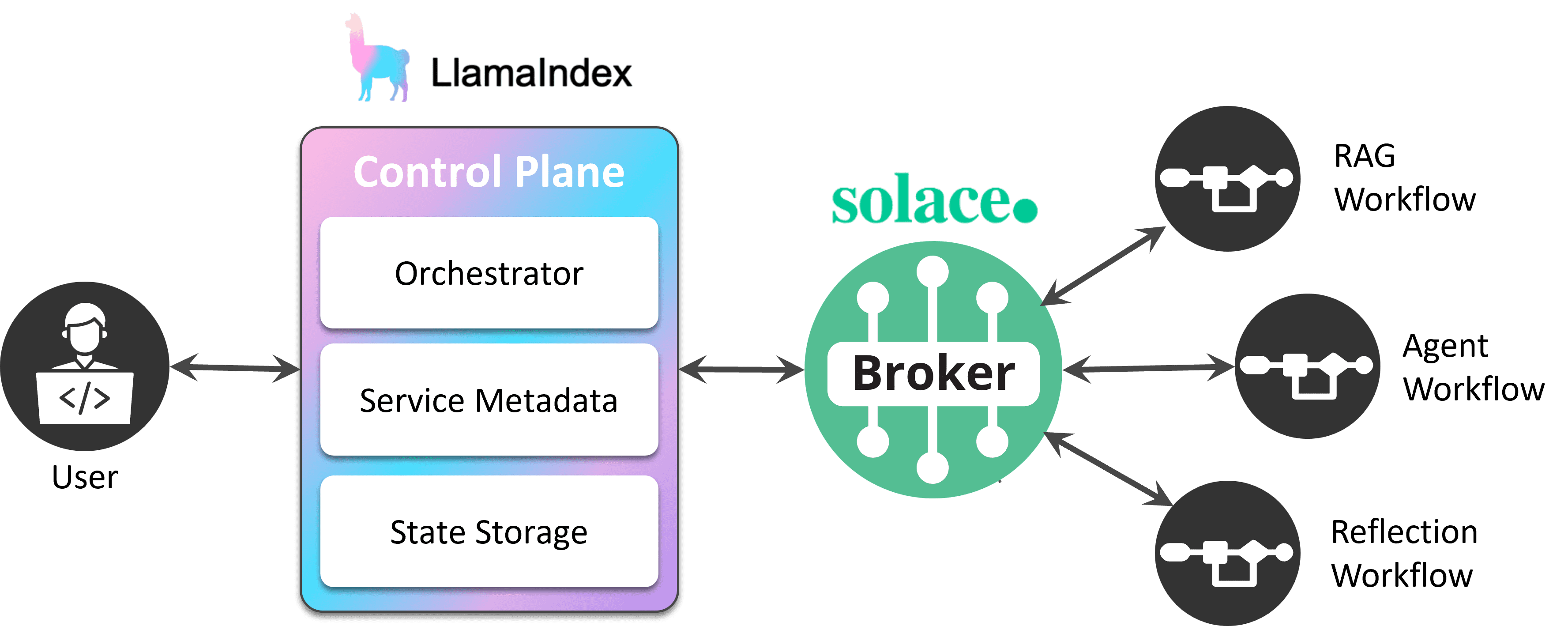Home > Blog > Artificial Intelligence
Fraud detection and reduction. Decreasing customer wait times by dynamically adjusting staffing levels. Ensuring that the pastries coming down the production line have the proper toppings. What do all these have in common? Real companies use AI to address these business challenges.As AI moves from POCs to production-critical use cases, concerns about reliability, security and enterprise-wide connectivity come to the forefront. Especially when it comes to precious things like pastries! How can you make sure that your AI runs as smoothly as any other component of your enterprise architecture?
One powerful solution combines:
- Solace’s industry-leading event-driven integration and streaming platform that connects your applications, devices and people with real-time information.
- LlamaDeploy (formerly llama-agents) an async-first framework for deploying, scaling, and productionizing agentic multi-service systems based on workflows from LlamaIndex.
What’s better, Solace’s platform is fully integrated with LlamaDeploy. You can learn how to configure Solace as LlamaDeploy’s event broker by reading this blog post on their site, and how to build AI applications with LlamaDeploy and Solace by reading my colleague Alireza’s blog post. Once you get the idea, visit the Quickstart guide on Github to get Solace and LlamaDeploy up and running in about 10 minutes!
The Importance of Agentic AI
Increasingly, solving real-world challenges requires multiple specialized AI models working in concert, along with up-to-the-second information about the current state of the world and your business with real-time retrieval augmented generation (RAG) workflows. These “agentic systems” revolve around the orchestration and coordination of multiple autonomous agents, with the goal of allowing them to collaborate on tasks, solve complex problems, and respond to real-time data.
Subscribe to Our Blog
Get the latest trends, solutions, and insights into the event-driven future every week.
Thanks for subscribing.
As business requirements mature, technical solutions also evolve—from ad hoc programming to repeatable tools for solving common problems. Agentic systems are proving to be no different. A number of solutions have emerged to meet the needs of businesses rushing to capitalize on the power of agentic AI by making it easier for architects and developers to integrate and orchestrate AI assets. In this case, LlamaDeploy, a popular open-source project, serves as collaborative AI framework, providing a consistent way of coordinating various agents to work together and performing logic on the results.
LlamaDeploy: A Framework for Agentic AI
Given the spotlight on AI in technical circles and concerned talk among non-technical people, it’s no shock that you can pick between multiple agentic frameworks. What makes LlamaDeploydifferent than many of its competitors? The secret sauce lies in being an event-driven framework.
As described in the documentation, LlamaDeploy easily transitions something that you built in a notebook to a production-ready service—”with the minimum amount of changes to the original code, possibly zero.” To pull off this transition, LlamaDeploy relies on an API server to expose the agents to end user. But more importantly, LlamaDeploy uses asynchronous events to move information between AI agents, which offers huge gains in reliability, speed and ease of deployment. For more information on LlamaDeploy’s architecture, check out this.
Even better, LlamaDeploy lets you choose which event broker to use for its asynchronous event distribution amongst agents. Existing options include Kafka, Redis, Rocket MQ…and now the Solace platform.
Why pair Solace with LlamaDeploy?
So, given a choice among various event brokers, why choose the Solace platform to pair with LlamaDeploy? Among many reasons:
- Enterprise-level scalability and reliability: Solace is trusted for mission-critical applications by many of the world’s biggest banks, stock markets, telcos, and transportation companies including airlines and aviation agencies like the FAA. They trust our guaranteed message delivery, built-in disaster recovery and class-leading observability with OpenTelemetry to run their businesses.
- Commitment to openness and flexibility: Solace embraces open standards like AsyncAPI, AMQP, JMS, MQTT, OpenTelemetry, and REST. That means a wide variety of options for connectivity and observability. And being cloud agnostic means that you aren’t locked into a single cloud provider or AI model–your events can flow between agents on any cloud, edge and on-premises environments, anywhere in the world.
- Rock-solid security: Every event is locked down by default for security, and the platform provides self-service access to developers, and automatically provisions necessary infrastructure on demand.
For more information on advantages of building an event mesh with Solace, check out From Silos to Symphony.
Got 10 minutes? Get going with Solace and LlamaDeploy
Combining Solace’s platform and LlamaDeploy means having a broker that can run anywhere, connect to anything with a platform that manages the details. That means you can focus on solving real problems with LlamaDeploy and not on data movement and integration. Want to see how to do it? Get up and running in about 10 minutes with the quick start guide.
Explore other posts from category: Artificial Intelligence

As an architect in Solace’s Office of the CTO, Jesse helps organizations of all kinds design integration systems that take advantage of event-driven architecture and microservices to deliver amazing performance, robustness, and scalability. Prior to his tenure with Solace, Jesse was an independent consultant who helped companies design application infrastructure and middleware systems around IBM products like MQ, WebSphere, DataPower Gateway, Application Connect Enterprise and Transformation Extender.
Jesse holds a BA from Hope College and a masters from the University of Michigan, and has achieved certification with both Boomi and Mulesoft technologies. When he’s not designing the fastest, most robust, most scalable enterprise computing systems in the world, Jesse enjoys playing hockey, skiing and swimming.


Subscribe to Our Blog
Get the latest trends, solutions, and insights into the event-driven future every week.
Thanks for subscribing.

